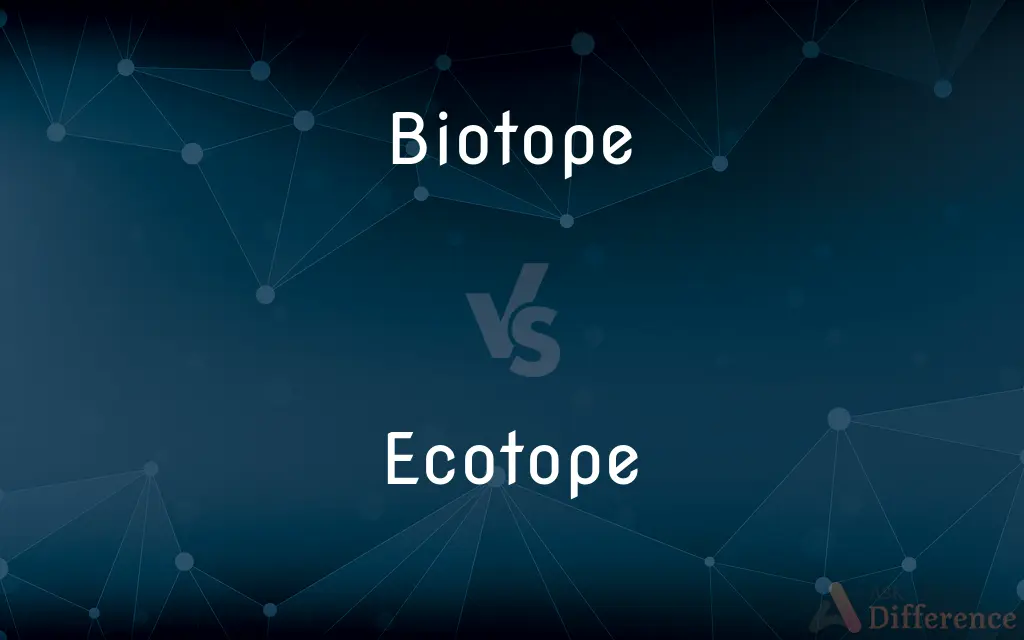Biotope vs. Ecotope — What's the Difference?
Edited by Tayyaba Rehman — By Maham Liaqat — Updated on March 6, 2024
A biotope is a smaller area with uniform environmental conditions and specific communities of life, focusing on habitat aspects. An ecotope, often used interchangeably with biotope, emphasizes the smallest ecologically distinct unit in a landscape.

Difference Between Biotope and Ecotope
Table of Contents
ADVERTISEMENT
Key Differences
Biotope and ecotope are terms used in ecology to describe areas of uniform environmental conditions, species, and ecological processes, but they focus on slightly different aspects. Ecotope, on the other hand, while closely related and sometimes used synonymously with biotope, tends to highlight the ecological processes and interactions within a particular area. It is considered the smallest spatially explicit unit in landscape ecology that is functionally distinct from its surroundings based on criteria like vegetation, soil type, topography, and human influence.
A biotope is often described as a habitat type, relating specifically to the physical space and the conditions necessary for a particular community of plants, animals, and other organisms to thrive. It's a term commonly used in conservation biology to emphasize the importance of preserving habitats for biodiversity. The concept of an ecotope integrates the biotic and abiotic factors and the interactions that define a unique ecological setting.
Both concepts are integral to understanding biodiversity and ecosystem function. Biotopes are crucial for conservation efforts, as protecting a biotope means preserving the specific conditions needed for the survival of particular species assemblages. Ecotopes provide a more detailed understanding of the ecological dynamics within a landscape, offering insights into how changes in the environment or species compositions might affect ecological balance.
The distinction between these terms also reflects their usage in different ecological studies and conservation strategies. Biotopes are more frequently used in habitat classification and biodiversity conservation, focusing on the physical and biological components necessary for species' survival. Ecotopes are used in landscape ecology and environmental management, emphasizing the dynamic interactions within ecosystems and their response to natural and anthropogenic changes.
Understanding the nuances between biotope and ecotope is essential for effective ecological research, landscape management, and conservation planning. Both concepts play a significant role in ecological studies, emphasizing the need to preserve the intricate balance between organisms and their environment to maintain biodiversity and ecosystem health.
ADVERTISEMENT
Comparison Chart
Focus
Habitat types and the conditions for specific communities of life.
Smallest ecologically distinct unit in a landscape, highlighting organism-environment interactions.
Emphasis
Physical space and conditions for life.
Ecological processes and interactions.
Used in
Conservation biology, habitat classification.
Landscape ecology, environmental management.
Importance
Preserving specific habitats for biodiversity.
Understanding ecological dynamics and responses to changes.
Examples
A coral reef biotope, a deciduous forest biotope.
An urban ecotope with its distinct vegetation, soil, and microclimate; a wetland ecotope.
Conservation Focus
Protecting the habitat for species survival.
Managing ecological processes for ecosystem health.
Studies
Biodiversity studies, species habitat requirements.
Ecological balance, species interactions within a landscape.
Outcome
Preservation of conditions necessary for specific species assemblages.
Insights into ecological balance and environmental management.
Compare with Definitions
Biotope
Classified based on physical and biological characteristics.
The coastal biotope is characterized by saline water and sandy soils.
Ecotope
Focuses on the interaction between organisms and their environment.
Researchers study how urbanization impacts the local ecotope's balance.
Biotope
A habitat type focusing on the living space of organisms.
Conservationists aim to protect the mountainous biotope from development.
Ecotope
Used in environmental management and landscape ecology.
Sustainable practices are implemented to maintain the health of the agricultural ecotope.
Biotope
Key to biodiversity conservation.
Each biotope in the rainforest harbors different species, contributing to the area's biodiversity.
Ecotope
The smallest ecologically distinct landscape unit.
The grassland ecotope plays a vital role in the region's ecological dynamics.
Biotope
A region with uniform environmental conditions and specific life communities.
The mangrove biotope supports a unique set of flora and fauna.
Ecotope
Includes both biotic and abiotic components.
The forest ecotope includes trees, soil types, and microclimatic conditions.
Biotope
Integral for species-specific conservation strategies.
Preserving the prairie biotope is crucial for the survival of many endemic species.
Ecotope
Helps understand ecosystem responses to changes.
Monitoring the wetland ecotope provides insights into effects of climate change on water levels and species diversity.
Biotope
An area that is uniform in environmental conditions and in its distribution of animal and plant life.
Ecotope
An ecological habitat on the scale of individual organisms sharing space. Many ecotopes together, either adjacent or overlapping, make up an eco-region or larger unit.
Biotope
A geographical area that has a uniform biological environment and a uniform distribution of plants and animals
Ecotope
Ecotopes are the smallest ecologically distinct landscape features in a landscape mapping and classification system. As such, they represent relatively homogeneous, spatially explicit landscape functional units that are useful for stratifying landscapes into ecologically distinct features for the measurement and mapping of landscape structure, function and change.
Biotope
A biotope is an area of uniform environmental conditions providing a living place for a specific assemblage of plants and animals. Biotope is almost synonymous with the term "habitat", which is more commonly used in English-speaking countries.
Ecotope
All of the constituent parts found in a locality on the same scale, such as the physiotope (landform), the geotope (rocks and soil) and the biotope (living flora and fauna).
Biotope
(figuratively) a context where someone feels 'naturally' at home, such as their field of professional or scientific expertise
Biotope
A region uniform in its environmental conditions and in the types of plants and animals living in it.
Common Curiosities
What is the primary difference between a biotope and an ecotope?
The primary difference lies in focus: biotope emphasizes the habitat and conditions for life, while ecotope emphasizes ecological processes and organism-environment interactions.
How does understanding ecotopes help in environmental management?
Understanding ecotopes allows for better management of ecological processes and responses to environmental changes, ensuring ecosystem health.
Can a biotope and an ecotope overlap in definition?
Yes, the terms are closely related and sometimes used interchangeably, but they have nuances in their focus and application in ecology.
Is the conservation of biotopes and ecotopes a global concern?
Yes, the conservation of these ecological units is crucial worldwide for maintaining biodiversity, ecosystem services, and combating the effects of climate change.
Can the concept of ecotopes be applied to urban environments?
Yes, urban ecotopes consider the unique ecological characteristics and processes within urban settings, including human-built environments and green spaces.
How do climate changes impact biotopes and ecotopes?
Climate changes can alter the conditions of biotopes, leading to shifts in species compositions, and affect the interactions within ecotopes, potentially destabilizing ecological processes and relationships.
Why is preserving biotopes important for biodiversity?
Preserving biotopes helps maintain the specific conditions necessary for the survival of certain species assemblages, supporting overall biodiversity.
Are biotopes or ecotopes larger in spatial scale?
Generally, both concepts can vary in scale, but ecotopes are defined as the smallest functionally distinct landscape units, suggesting a more detailed focus.
How do human activities affect biotopes and ecotopes?
Human activities can alter the physical conditions of biotopes and disrupt the ecological processes within ecotopes, affecting biodiversity and ecosystem function.
What role do biotopes play in ecosystem services?
Biotopes contribute significantly to ecosystem services by providing habitat for species that pollinate crops, control pests, and support water purification and carbon sequestration processes.
What methods are used to monitor the health and changes of biotopes and ecotopes?
Methods include remote sensing, field surveys, species inventory, ecological modeling, and monitoring environmental parameters like soil moisture, temperature, and species composition to assess and track changes over time.
How are biotopes and ecotopes identified and classified?
They are identified and classified based on a combination of physical (such as soil type, water availability) and biological factors (such as dominant species), as well as their distinct ecological functions within a landscape.
Can the restoration of a damaged biotope restore its original ecotope functions?
Restoration efforts can rebuild the physical habitat (biotope) and, over time, may restore the original ecotope functions, but this process is complex and depends on the reestablishment of ecological processes and interactions.
Share Your Discovery

Previous Comparison
Edema vs. Anasarca
Next Comparison
Drink vs. SinkAuthor Spotlight
Written by
Maham LiaqatEdited by
Tayyaba RehmanTayyaba Rehman is a distinguished writer, currently serving as a primary contributor to askdifference.com. As a researcher in semantics and etymology, Tayyaba's passion for the complexity of languages and their distinctions has found a perfect home on the platform. Tayyaba delves into the intricacies of language, distinguishing between commonly confused words and phrases, thereby providing clarity for readers worldwide.
















































